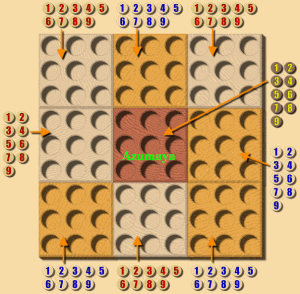Objective
Each player has four territories on the SUDOKU-game board.
At each turn a player should place a SUDOKU-counter in one of his own territories according to the SUDOKU-rules.
The SUDOKU-rules are familiar: in each territory, row, and column, a number may appear only once. This rule applies to the entire field, i.e. also the the opponent's territory.
It is allowed and intended to prevent the opponent from completing his territories by means of tactical placement of counters. The player who places the last piece wins the game.
Terms
- Moyo = Influence
- Azumaya = small house. An Azumaya is open to all sides, so it is essentially a roof on poles.
In the game: Neutral territory in the center of the board; here the game is started.
- Shima = own land, garden, island. Here it means the territory of a player (= 3x3 square)
Contents
-
81 SUDOKU-counters with numbers 1-9
One player places the light SUDOKU-counters, the other player places the dark SUDOKU-counters.
The black SUDOKU-counters are neutral.
|
Player 1 (light) |









|
|
Player 2 (dark) |









|
|
Both players (black) |









|
-
15 Moyo-pieces without numbers to mark impossible spaces

-
A game board containing 9 territories (Shima) - 3x3 square each:
- 4 light Shima for the player with the light SUDOKU-counters
- 4 dark Shima for the player with the dark SUDOKU-counters
- 1 Azumaya in the middle of the board: This is the area for the neutral black SUDOKU-counters

Game Setup
At first, the default counters are placed according to the puzzle.
The SUDOKU-counters for the Azumaya (middle) are placed there, the SUDOKU-counters of the players are placed in the surrounding area.
The remaining SUDOKU-counters are sorted next to the playing field, so that it is always clear to which field the remaining counters belong.
Remark: In the online-version, a sudoku-puzzle is randomly selected from a list of puzzles. The playing field is set up automatically according to this puzzle.
Opening
First the neutral Azumaya (middle) is filled with SUDOKU-counters. Only if no SUDOKU-counter can be placed here, the players are allowed
to place SUDOKU-counters into their own Shima. At no time a player is allowed to place SUDOKU-counters into fields of the opponent.
Turn
The player on turn places one piece on the board in compliance with the Sudoku-rules: A number may not appear twice in the same row, column or territory. However, it is allowed to place pieces that prevent the Sudoku from being solved.
If there is a space that cannot be occupied with a piece anymore, a Moyo-piece is placed at that space.
If a piece cannot be placed into its territory (Shima) anymore it is turned over.
Neither the placing of a Moyo-piece, nor the turning over of a stone is considered a turn. Both actions are only used to make the game situation clearer and can happen at any time.
Remark: The online-version places Moyo-pieces automatically and marks SUDOKU-counters that cannot be placed anymore.
End of game
The game ends if one player can no longer place a SUDOKU-counter. The player to place the last piece in his territory (Shima) wins the game.